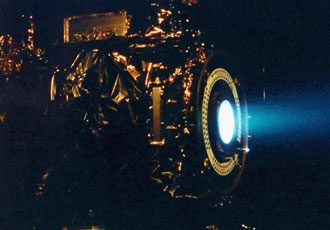Mission Overview
Spacecraft
Most systems on the spacecraft are redundant, meaning that there is a backup available if the main system encounters a problem. Automated onboard fault protection software will sense any unusual conditions and attempt to switch to backups.
With its solar array in the retracted position (for launch), the Dawn spacecraft is 2.36 meters (7 feet, 9 inches) long -- about as long as a large motorcycle. With its wide solar arrays extended, Dawn is about as long as a tractor-trailer at 19.7 meters (65 feet).
Ion Propulsion
The ion propulsion system will provide the Dawn spacecraft with the thrust that it will require to reach its target asteroids. The demanding mission profile would be impossible without the ion engines -- even a mission only to asteroid Vesta (and not on to Ceres) would require a much larger spacecraft and a dramatically larger launch vehicle. Ion propulsion was proved on NASA's Deep Space 1 mission, which tested it and 11 other technologies while journeying to an asteroid and a comet.

Image above: An ion propulsion system test. Image credit: NASA/JPL
+ Larger view
Each of Dawn's three 30-centimeter-diameter (12-inch) ion thrust units is movable in two axes to allow for migration of the spacecraft's center of mass during the mission. This also allows the attitude control system to use the ion thrusters to help control spacecraft attitude.
A total of three ion propulsion engines are required to provide enough thruster lifetime to complete the mission and still have adequate reserve. However, only one thruster will be operating at any given time. Dawn will use ion propulsion for years at a time, with interruptions of only a few hours each week to turn to point its antenna to Earth. Total thrust time through the mission will be about 2,100 days, considerably in excess of Deep Space 1's 678 days of ion propulsion operation.
The thrusters work by using an electrical charge to accelerate ions from xenon fuel to a speed 10 times that of chemical engines. The electrical level and xenon fuel feed can be adjusted to throttle each engine up or down. The engines are thrifty with fuel, using only about 3.25 milligrams of xenon per second (about 10 ounces over 24 hours) at maximum thrust. The Dawn spacecraft carries 425 kilograms (937 pounds) of xenon propellant.
At maximum thrust, each engine produces a total of 91 millinewtons -- about the amount of force involved in holding a single piece of notebook paper in your hand. You would not want to use ion propulsion to get on a freeway -- at maximum throttle, it would take Dawn's system four days to accelerate from 0 to 60 miles per hour.
As slight as that might seem, over the course of the mission the total change in velocity from ion propulsion will be comparable to the push provided by the Delta II rocket that carried it into space -- all nine solid-fuel boosters, plus the Delta's first, second and third stages. This is because the ion propulsion system will operate for thousands of days, instead of the minutes during which the Delta performs.
More Spacecraft Information
+ Spacecraft instruments